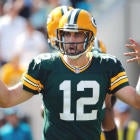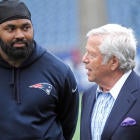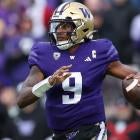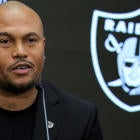The Packers appeared to be on the verge of collapse after suffering a fourth straight defeat in a Week 11 game against the Redskins. An eighth consecutive playoff appearance seemed unlikely. The Packers were behind the Lions and Vikings in the NFC North standings with a 4-6 record when quarterback Aaron Rodgers suggested Green Bay could run the table to extend the streak. Playing some of the best football of his career while battling right calf and left hamstring injuries, Rodgers led the Packers to six straight wins to finish atop the NFC North.
Two postseason victories followed, including a 34-31 thriller over the NFC's top-seeded Cowboys, before bowing out of the playoffs in the NFC Championship Game. Packers head coach Mike McCarthy aptly described the lopsided 44-21 loss to the Falcons by saying, "We ran into a buzzsaw."
Here's a preview of things to come for the Packers during the offseason.
Ted Thompson's roster building philosophy
Executive vice president/general manager/director of football operations Ted Thompson strictly adheres to a draft-and-develop approach in building Green Bay's roster. It's been a success. The Packers have a 118-73-1 record in his twelve years running the team, including a Super Bowl XLV championship. Although Thompson is adept at drafting, his methodical approach is beginning to come under scrutiny.
Thompson's aversion to utilizing free agency and making trades to acquire veteran talent has become increasingly frustrating for McCarthy. Rodgers may have been taking a jab at Thompson with his remark about needing to go all-in every year to win after the Falcons loss.
It may be time for Thompson to start emulating his protégés running other NFL teams. John Dorsey, Reggie McKenzie and John Schneider are more willing to take chances in assembling the rosters of the Chiefs, Raiders and Seahawks.
Dorsey gave the 49ers two second-round picks for quarterback Alex Smith in 2013 early in his tenure with Chiefs. He also spent significant money on wide receiver Jeremy Maclin in free agency.
The Raiders have one of the NFL's best offensive lines because of McKenzie's willingness to embrace free agency with big ticket signings center Rodney Hudson and guard Kelechi Osemele.
The offensive identify of Seattle's Super Bowl XLVIII-winning team came from Schneider acquiring running back Marshawn Lynch in a 2010 trade with the Bills. Defensive ends Cliff Avril and Michael Bennett are instrumental in Seattle having the NFL's stingiest defense over the last four seasons, and the two initially joined the Seahawks as value signings in free agency.

Thompson should be encouraged by his limited forays into free agency. Surprisingly, he quickly snapped up defensive end Julius Peppers after the Bears released him in 2014. Rams castoff Jared Cook, an offseason signee, played an important role in Green Bay's turnaround this season. Most notably, Thompson was responsible for arguably the second-most impactful veteran free agent signing in franchise history when he landed defensive back Charles Woodson in 2006. During the future Hall of Famer's seven years in Green Bay, a Super Bowl was won, he earned NFL Defensive Player of the Year honors and provided excellent leadership.
There has been speculation that Thompson, who recently turned 64, would retire. He is under contract through the 2018 season. Dorsey and current Green Bay executive Eliot Wolf are considered the leading candidates to replace Thompson whenever his time running the Packers comes to an end.
Salary cap
The Packers have approximately $145.5 million of 2017 salary cap obligations with 47 players under contract. Almost $8 million of unused cap room is being carried over from the 2016 league year.
The NFL's preliminary projections for the 2017 salary cap are between $166 million and $170 million. Assuming the salary cap is set at $168 million, the Packers have a little under $27 million of salary cap space once tenders for restricted free agents and exclusive rights players with expiring contracts, and the proven performance escalator for eligible 2014 draft picks, are taken into consideration using offseason accounting rules. Only the top 51 cap numbers matter in the offseason.
Sam Shields' career may be in jeopardy because of concussion issues. He only played in the regular-season opener due to suffering what is believed to be the fifth concussion of his career. Although Shields wants to continue playing, he is still having lingering effects from his last concussion. He also recently pleaded not guilty to a marijuana possession charge stemming from an October arrest at his Green Bay area residence.
Shields has Green Bay's fourth biggest 2017 cap number at $11,656,250. The Packers would pick up $8,531,250 of cap room by cutting Shields or seeing him retire.
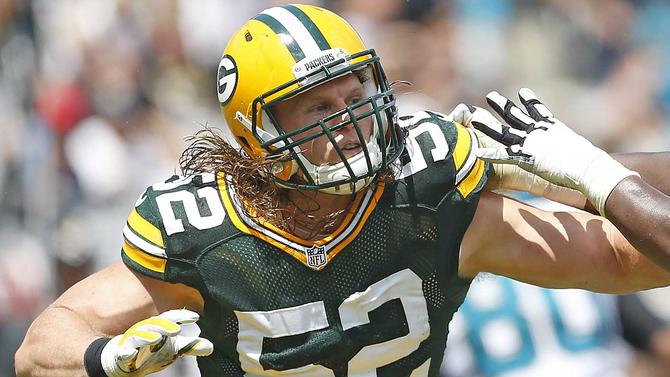
Guard Josh Sitton was a surprise preseason cut despite being named second-team All-Pro in each of the three previous seasons. As such, Clay Matthews shouldn't breathe easy after an injury-plagued and disappointing season. Green Bay's pass-rushing uncertainties could be his saving grace. Nonetheless, he could be asked to take a pay cut. Matthews is scheduled to make $11.1 million next season with a $15.075 million cap number, which is second highest on the team.
Wide receiver Randall Cobb may also be a pay-cut candidate because he hasn't lived up to the four-year, $40 million contract he signed in 2015 after a season with 91 catches, 1,287 yards and 12 touchdowns. His $12,656,250 2017 cap number is Green Bay's third highest. His 2017 salary is $9.5 million.
Backup running back James Starks could be another source of cap room. He had fallen out of favor when a concussion in a December traffic accident ended his season. Green Bay would pick up $2,868,750 of cap room by letting him go.
Free agency/team needs
The Packers have 14 unrestricted free agents, including tight end Jared Cook, defensive back Micah Hyde, running back Eddie Lacy, offensive guard T.J. Lang, center J.C. Tretter and outside linebackers Datone Jones, Julius Peppers and Nick Perry. Linebackers Jayrone Elliott and Jordan Tripp are Green Bay's two restricted free agents. The Packers could decide against tendering them because the lowest amount is approximately $1.8 million.
Green Bay felt so good about its cornerbacks after last season that Casey Hayward taking a three-year, $15.3 million free agent contract from the Chargers didn't seem like a big deal. Now cornerback is the biggest area of need because of Shields' career being in danger and Green Bay's top two draft picks in 2015, Damarious Randall and Quinten Rollins, suffering sophomore slumps.
In hindsight, more of an effort should have been made to keep Hayward. He earned his first Pro Bowl berth by leading the NFL with seven interceptions while becoming more of a boundary cornerback than he ever was in Green Bay.
These developments could have Thompson making one of his rare explorations into the free agent market, for a cover man. The top available cornerbacks, which include A.J. Bouye, Stephon Gilmore and Trumaine Johnson, will be in the high-rent district targeting deals in excess of the $12.5 million per year with $28.8 million guaranteed, such as the one Janoris Jenkins got from the Giants last year on the open market. Prince Amukamara and Morris Claiborne should be more affordable.
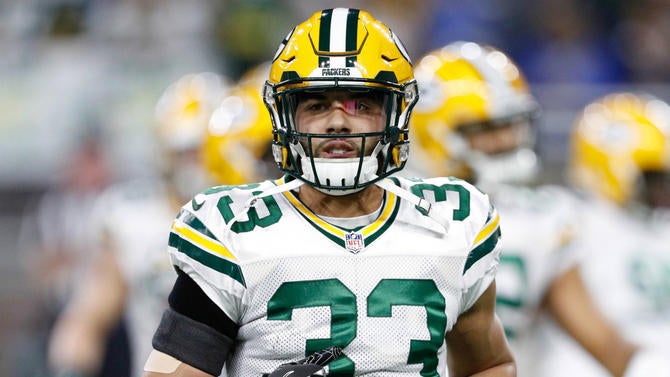
Retaining Hyde may have increased in importance because of the question marks in the secondary. Hyde's versatility, which allows him to assume multiple roles in Green Bay's defense, could net him a bigger deal than Hayward's to stay put.
The pass rush is almost as big of a concern as the secondary. Perry had a breakout season after returning to Green Bay on a one-year deal worth $5 million. He tied for eighth in the NFL with 11 sacks. The three-year deal Peppers signed in 2014 averaging $8,666,667 should serve as Perry's salary floor to remain in Green Bay. The extension Matthews signed in 2013 at $13.2 million per year, which made him the NFL's highest-paid linebacker at the time, is probably Perry's salary ceiling with the Packers. It's conceivable another team would give him more, because pass rushers are paid a premium.
Peppers still has gas left in the tank despite being 37 years old. His 7.5 sacks were second on the team to Perry. The nine-time Pro Bowler hasn't decided whether he is going to retire. Since he would be a case of diminishing returns because of his age, he would probably only be brought back if he is willing to take a substantial pay cut. The Packers passed on a fifth-year option for Jones, a 2013 first-round pick, in 2017 at $8.069 million because of his inability to make a mark at defensive end or outside linebacker. After generating only one sack this season, his return would like be on a one-year, prove-it deal, like Perry but at a fraction of his option year price.
The leverage Lang gained over the Packers with Sitton's release may have been undercut by his upcoming hip surgery and broken left foot. Thompson has been successful in getting his free agents, like Cobb and right tackle Bryan Bulaga, to take a little bit of a discount to re-up with Green Bay. It's hard to imagine Lang, a first time Pro Bowler this season, accepting less than the $7 million per year Sitton received from the Bears after the Packers cut him. Lang could price himself out of Green Bay by seeking a contract comparable to the $10 million per year preseason extensions David DeCastro and Kyle Long received from the Steelers and Bears, respectively.
First-round pick Jason Spriggs didn't inspire much confidence that he could make a conversion from tackle, neither in the two late-season starts he received because of Lang's foot, nor after a re-aggravation forced the veteran out of the Falcons game. Tretter, who can play anywhere on the offensive line, could be re-signed as a much cheaper alternative to Lang, but his injury history makes it a risky proposition.

Rodgers is already lobbying for Cook's return. Since he could be the beneficiary of a really weak crop of free agent tight ends, it may take more than the $5.5 million per year an aging Antonio Gates got to remain with the Chargers last offseason.
Lacy was well on his way to putting a disappointing 2015 campaign, in which weight issues contributed to a loss of playing time, when a left ankle injury requiring surgery ended his season after five games. A better-conditioned Lacy was on pace for more than 1,150 rushing yards while averaging 5.1 yards per carry. The injury may have cost Lacy a shot this upcoming offseason at the lucrative second contract that sometimes eludes running backs. For example, Chris Ivory and Lamar Miller received long-term deals last offseason averaging in excess of $6.25 million per year.
Ty Montgomery did an admirable job in his transition from wide receiver to running back after Lacy's injury. Since he probably isn't a workhorse back, a ball carrier could be in found in the fairly deep draft class in addition to or in lieu of Lacy.
Outlook
Rodgers can almost single-handedly keep the Packers competitive for the next few years, because his greatness can help mask roster deficiencies like Peyton Manning's did during most of his time with the Colts. The two-time league MVP isn't going to have a big margin for error come playoff time when trying to win another championship unless Thompson or his eventual successor heed his advice about reloading the roster.












